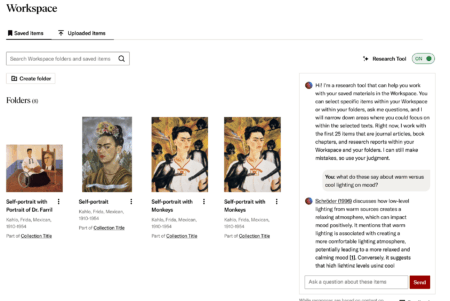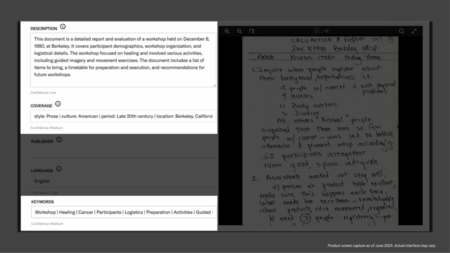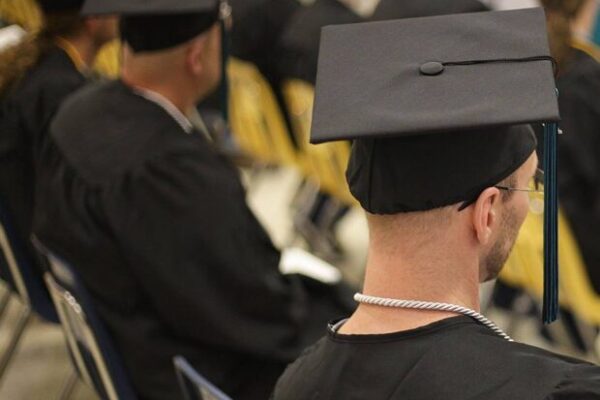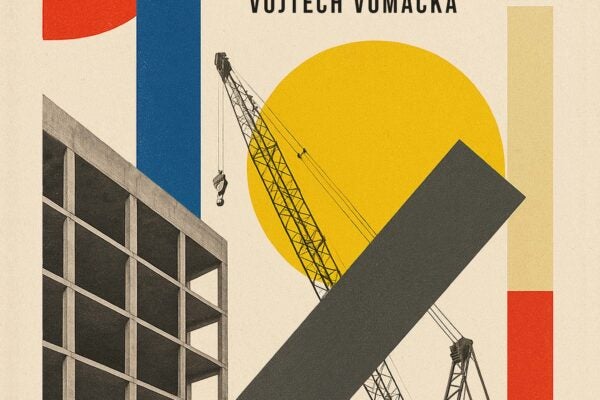This year’s American Library Association (ALA) Conference in Philadelphia offered an opportunity to share how JSTOR is addressing two interconnected needs: helping researchers navigate trusted content more intuitively, and helping libraries manage, preserve, and activate distinctive collections at scale.
Our tech talk followed the full lifecycle of digital collections, including ingest and processing, long-term preservation, and engagement with researchers. We also shared the ways in which each solution is grounded in collaboration with the library community.
AI-powered discovery and engagement on JSTOR

In terms of discovery, we demonstrated our dual-path search experience. Keyword search supports precise term matching, while semantic search enables natural language queries that return conceptually relevant results.
The AI research tool, currently available for journal articles and book chapters (with primary sources and images on the roadmap), offers context as to how a document relates to a search query, and provides abstracts or short overviews when none exist. To help researchers explore further, the tool generates recommended topics and related content suggestions drawn from across the JSTOR corpus. The “Ask a question” feature acts like a conceptual search within the document, returning only answers that are supported by the text in view, with each one linked directly to its source passage.
Feedback from librarians at ALA emphasized that transparency—both in how responses are generated and in clear attribution—builds trust. Users also appreciated the ability to download conversation histories or cite the tool’s outputs in their own work.
Advancing digital collections stewardship

Our conversations at ALA confirmed what we’ve been hearing in interviews and conversations with libraries and archives around the world over the past few years: many institutions are working with growing distinctive collections, limited resources, and disparate tools that don’t connect well with one another. JSTOR Digital Stewardship Services was designed in collaboration with librarians, archivists, and curators to address those challenges by providing an integrated platform that unites processing, cataloging, discovery, and preservation. Institutions can adopt it in full or start with the components that meet their immediate needs.
The platform brings together key stewardship capabilities in a unified environment:
- AI-assisted processing, including metadata generation and project-level intelligence, with JSTOR Seeklight
- Digital asset management with flexible cataloging tools Discovery and research access through JSTOR and indexing in major search engines such as Google
- Long-term digital preservation with Portico
These capabilities are designed as part of a single experience, while still offering institutions the flexibility to begin where they are ready and expand over time. The system supports multiple entry points within a unified workflow. Libraries might begin with preservation, focus first on access, or loop back to enrich metadata as priorities shift—all within the same environment.
JSTOR Seeklight accelerates collection processing by producing an initial set of descriptive metadata fields, tagged as AI-generated for transparency and accompanied by confidence scores to help prioritize review. This human-in-the-loop approach mirrors what resonated in our AI research tool demonstration: the combination of efficiency and clear signals about reliability and the centrality of human expertise.
At ALA, we demonstrated the simple but powerful drag-and-drop upload interface for JSTOR Seeklight, including how items can be grouped into compound objects, with optional contextual fields to guide metadata generation. In one example, we processed a handwritten manuscript; in another, an annotated engineering drawing of the Brooklyn Bridge; in another, an embroidered textile in Spanish. We also highlighted the time savings JSTOR Seeklight can bring, empowering collection stewards to focus their efforts on higher-order priorities. Projects that might once have required nine to ten weeks of full-time work can now be initially processed in under two hours. Crucially, human expertise remains at the center—JSTOR Seeklight expands capacity without replacing professional judgement.
Insights from the community
Attendees underscored the importance of clarity about sources and scope in both stewardship workflows and research tools. The idea to integrate preservation at the outset rather than as an afterthought resonated strongly, as did the flexibility to adopt the full stack or just the components that meet immediate needs. Additionally, librarians expressed interest in programming to help faculty teach with the AI research tool. Suggestions included webinars hosted jointly with Centers for Teaching and Learning (CTLs), covering topics such as AI literacy, prompt literacy, and designing assignments that incorporate AI responsibly.
Sustainability was another point of discussion. We shared how JSTOR’s architecture supports more efficient small language models where appropriate, caches stable responses to reduce repeated computation, and can adapt to more sustainable models without service interruption.
Looking ahead
The AI research tool rolled out to all JSTOR-participating institutions in July after two years of development in accordance with librarian and faculty feedback. Our next steps include deepening adoption through continuing to refine usability for librarians, educators, and researchers, as well as ensuring sustainable, transparent operations on the whole.
Around Stewardship, JSTOR Seeklight was recently awarded the 2025 C.F.W. Coker award by the Society of American Archivists (SAA). We’re honored to have been recognized by the archival community for bringing together archival values, innovative technology, and a shared commitment to long-term stewardship. As we continue to evolve JSTOR Stewardship, our focus remains on strengthening a seamless, end-to-end experience that unites preservation, description, and discovery.
The conversations and demonstrations at ALA underscored how much can be achieved when technology and library expertise work in tandem. We left Philadelphia with a clearer sense of priorities and a renewed commitment to helping collections and scholarly materials reach the people who need them.



